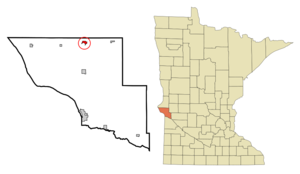- Graceville, Minnesota
Infobox Settlement
official_name = Graceville, Minnesota
settlement_type =City
nickname =
motto =
imagesize =
image_caption =
image_
imagesize =
image_caption =
image_
mapsize = 250px
map_caption = Location of Graceville, Minnesota
mapsize1 =
map_caption1 =subdivision_type = Country
subdivision_name =United States
subdivision_type1 = State
subdivision_name1 =Minnesota
subdivision_type2 = County
subdivision_name2 = Big Stonegovernment_footnotes =
government_type =
leader_title =
leader_name =
leader_title1 =
leader_name1 =
established_title =
established_date =unit_pref = Imperial
area_footnotes =area_magnitude =
area_total_km2 = 1.6
area_land_km2 = 1.6
area_water_km2 = 0.0
area_total_sq_mi = 0.6
area_land_sq_mi = 0.6
area_water_sq_mi = 0.0population_as_of = 2000
population_footnotes =
population_total = 605
population_density_km2 = 389.1
population_density_sq_mi = 1007.7timezone = Central (CST)
utc_offset = -6
timezone_DST = CDT
utc_offset_DST = -5
elevation_footnotes =
elevation_m = 339
elevation_ft = 1112
latd = 45 |latm = 34 |lats = 10 |latNS = N
longd = 96 |longm = 26 |longs = 16 |longEW = Wpostal_code_type =
ZIP code
postal_code = 56240
area_code = 320
blank_name = FIPS code
blank_info = 27-24758GR|2
blank1_name = GNIS feature ID
blank1_info = 0644309GR|3
website =
footnotes =Graceville is a city in Big Stone County,
Minnesota ,United States . The population was 605 at the 2000 census.Geography
According to the
United States Census Bureau , the city has a total area of 0.6square mile s (1.6km² ), all of it land.U.S. Route 75 andMinnesota State Highway 28 are the two major highways that run through the community. The town'smain street is named Studdart Avenue.History
Graceville was originally granted to
Archbishop John Ireland of Saint Paul,Minnesota . Wishing to settle the Minnesota prairie with CatholicIrish-Americans , he actively promoted settlement in Graceville and the surrounding region. The town was named for BishopThomas Grace and a special line was built across the prairie from Morris,Minnesota .In the summer of 1880, Archbishop Ireland paid for the passage of a ship filled with Famine refugees from the
Connemara inCounty Galway . Arriving in Graceville too late to adequately prepare and having little grasp of English, theIrish language speakers were ill prepared for the massive blizzard which descended in the winter. As both theProtestant Freemasons of Morris and the English speaking Irish-Americans of Graceville both schemed to manipulate the situation for their own ends, the sufferings of the Connemara refugees became an international scandal.With the future of his entire
Catholic Colonization Bureau in jeopardy, Archbishop Ireland offered up the "Conamaras" as a sacrifice, condemning them as shiftless, lazy and drunken. In the early months of 1881, all but three families were evicted from their claims and resettled in ashantytown in Saint Paul which was instantly dubbed The Connemara Patch. Meanwhile back in Graceville, the name "Conamara" became an insult, a pejorative term for a lazy, drunken failure. Archbishop Ireland would later describe the scandal as the greatest grief of his life.Toquatennial Days
In an effort to promote tourism, the Graceville City Council began Toquatennial Days on the first weekend of July in 1988, the 110th Anniversary of the town's founding. Events included the crowning of "Miss Toquatennial" (entants limited to women who would be seniors at the high school), a "Medallion Hunt", softball tournament, a Sunday evening ice cream social and drag competition (an apparent parade of past Miss Toquatennials), two street dances (a free "kiddie" dance on Friday night, and the Graceville Volunteer Fire Department Fundraiser dance on Saturday night), and the Saturday morning "Graceville Gallop", a six kilometer walk/run event that circles Toqua Lake. The events culminated with a firworks display at dusk Sunday evening over Toqua Lake. Events continued to be held annually on the first weekend of July or last weekend of June until the City Council was disbanded in 1998, but several local businesses and the Volunteer Fire Department have independently kept many of the events going every year, including the addition of a 3-on-3 basketball tournament and fire department "water fights".
Demographics
As of the
census GR|2 of 2000, there were 605 people, 257 households, and 149 families residing in the city. Thepopulation density was 1,007.7 people per square mile (389.3/km²). There were 283 housing units at an average density of 471.4/sq mi (182.1/km²). The racial makeup of the city was 99.50% White, 0.17% Native American, 0.17% Asian, and 0.17% from two or more races. Hispanic or Latino of any race were 0.17% of the population.There were 257 households out of which 26.8% had children under the age of 18 living with them, 51.4% were married couples living together, 5.1% had a female householder with no husband present, and 42.0% were non-families. 39.7% of all households were made up of individuals and 22.2% had someone living alone who was 65 years of age or older. The average household size was 2.15 and the average family size was 2.92.
In the city the population was spread out with 22.3% under the age of 18, 5.1% from 18 to 24, 21.8% from 25 to 44, 18.2% from 45 to 64, and 32.6% who were 65 years of age or older. The median age was 46 years. For every 100 females there were 80.1 males. For every 100 females age 18 and over, there were 74.7 males.
The median income for a household in the city was $27,143, and the median income for a family was $35,385. Males had a median income of $27,031 versus $21,250 for females. The
per capita income for the city was $15,451. About 3.9% of families and 8.6% of the population were below thepoverty line , including 10.7% of those under age 18 and 12.1% of those age 65 or over.Famous Residents
* Congresswoman
Madeleine Bordallo
* Birthplace of former Twins Manager Tom Kelly
* LegendaryIrish language storytellerÉamon a Búrc (1866-1942) was a resident in the early years of settlement.
* Birthplace of Hollywood film-maker Jack Conway (1887-1952)References
Further reading
* Bridget Connelly, "Forgetting Ireland; Uncovering a Family's Hidden History,"
Borealis Books ,Minnesota Historical Society , 2003.
Wikimedia Foundation. 2010.


